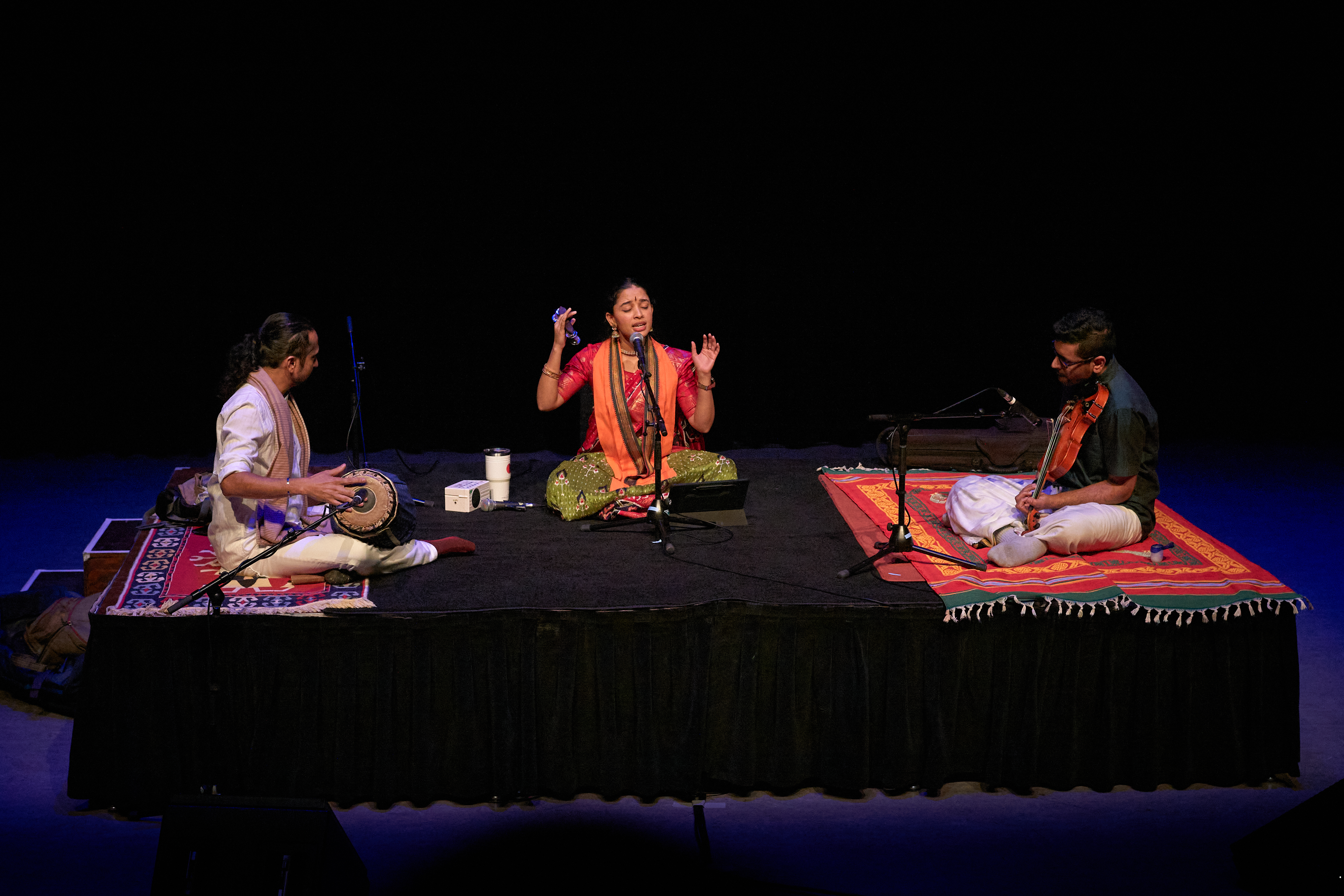
The 4th Annual Stand Festival platformed a unique program titled Katha-Keertana Chronicles on November 5th, 2024 at The Annex in Downtown Vancouver. This event shone a spotlight on a musical storytelling tradition practiced by Hindu bards in the Kannada speaking region of India. Featuring the songs and life story of Purandara Dasa, this evening was headlined by the melodic vocals of Sharvari Somayaji, accompanied by Shriram Rajagopalan on the violin and Keerthy Raghavan on the mridangam.
Taking on the role of bard, Somayaji’s narration was a sing-song discourse in English, punctuated by vocal compositions (Daasara Padagalu) in the Kannada language composed by the 15th century Kannada mystic Purandara Dasa, also known as the father of Carnatic music. The narrative centered on Purandara Dasa–an oral legend about his miraculous transformation from a selfish merchant into a hari-katha Bard. His original Keerthanas were translated faithfully by the vocalist. Somayaji’s translation from Kannada to English retained the poetic sensibilities of the original lyrics. The instrumental musicians pleasantly complemented the oration-centric format. Before I critique the story-telling (Katha) component, allow me a brief digression.
Going back millennia, the land known to us today as India, has been a melting pot of cultures. The spiritual schools that have dominated the social fabric include Brahmanism, Buddhism, Jainism and Islam–a complex melange owing to countless migrations, invasions, revolutions and counter-revolutions. During the Gupta Age (3rd-6th Centuries C.E), Brahmanical ideals – centering concepts like law (dharma), economic well-being (artha), sensual pleasure (kama) and salvation of the soul (moksha) – saw a resurgence in the form of Sanskrit literature (Puranas). Hindu sects such as Vaishnavism (Vishnu as supreme deity) and Saivism (Shiva as Supreme deity), bolstered by their respective Puranas trace their origins to this period. Regardless of sect, Puranic stories were bardish recollections of pseudo-historic periods, with a heavy emphasis on a mythical Dark Age (Kali Yuga). These stories were not accessible for the masses since the Puranas were Sanskrit texts. The contemporary South Indian counterpart, post-Sangam literature (such as Thirukkurals), espoused oral traditions of moral wisdom and spirituality using concepts like love, war, ethics and nature, in Tamil. These were largely secular texts and accessible to common masses.
The disparate developments of Puranic texts and folk wisdom were potentially consolidated by the pan-India Bhakti movement, in various phases spread across a few centuries.
The Bhakti phase from 6th-12th centuries was one of cultural revolution, resulting in syncretic spiritual schools such as Varkaris, Sufis and Lingayats. In the Maharashtra region, Varkari poets like Chokamela sang devotional poems (Abhangs) to Vithala, a folk deity residing in a temple (Pandarapura) on the sandy banks of river Bhima. Abhangs were embraced by the masses, enabling a connection to spiritual realm through personal devotion (Bhakti). In Karnataka, Vachana poets like Madara Chennaiah and Haralayya represented the downtrodden, composing hymns (Vachanas). Some (if not all) Vachanas rejected brahmanical dogma and hegemonic notions of purity and pollution assigned based on caste location. These poems speak of a divine consciousness in vernacular dialects, thus circumventing doctrinal frameworks like caste and patriarchy.
Brahmanical philosophers like Ramanuja and Madhwacharya contributed to the Bhakti movement, albeit in a manner that co-opted folk wisdom into the aegis of Brahmanism. They spawned schools of Vaishnavite (upholding Vedas and Puranas of Vishnu) philosophy that were initially embraced only by privileged caste communities. Vernacular art forms like Harikatha and Dasa Sahitya became popular vessels to spread Brahmanism among the masses in Kannada and Telugu speaking regions.
Purandara Dasa’s devotional songs in Kannada channeled the spiritual passion and devotion of Vachana and Varkari poets while infusing them with ideals of orthodox Vaishnavism and brahmanical patriarchy. The mythologisation of this bard’s privileged origins via a premodern “Monk who sold his Ferrari” archetype helps Purandara Dasa stay relevant as an agent of Hindu fundamentalists.
Somayaji’s retelling of Purandara Dasa’s origins and the ensuing moral discourse was ahistorical and was brimming with Brahmanical biases. There were some desperate attempts to paint the orthodox Vaishnavite saint as a cheerleader of gender equality and progressive reforms, while his compositions indicate otherwise. The Katha component, however, stayed true to the great guru-shishya parampara of regurgitating Brahman indoctrination without engaging in critical discourse.
– Annapoorna Shruthi
